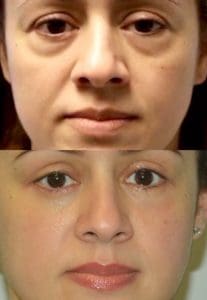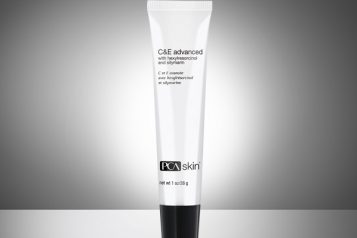Age-related eye-area changes come in many forms, including dark circles, puffiness or bags, crow’s feet and sagging eyelids—and many women and men experience more than one (or even all) of them. Miami Beach, Florida plastic surgeon Dr. Jose Rodríguez-Feliz explains the causes of these concerns as well as the best ways to fix them.
The problem: Dark circles
In many cases, dark circles are related to loss of fat around the eyes (and the resulting hollowness), puffiness or bags that create shadows under the eyes. Thinning skin that causes underlying blood vessels to become visible is another cause of darkness as well. Some patients are also genetically predisposed to skin discoloration, and sleep deprivation, allergies and dehydration can contribute to dark circles as well.
The solutions: This is one of the most difficult areas to treat, and patients tend to get very desperate since dark circles are often the first thing they see when they look in the mirror. Non-surgical treatments can help, but a surgical procedure may be ideal for long-term results. Every skincare regimen should include an eye-area product that helps treat hyperpigmentation, builds collagen and keeps the skin hydrated, and non-surgical treatments like microneedling, chemical peels and lasers can provide significant improvement. Hyaluronic acid fillers have gained popularity for treating tear troughs, but in my opinion, the best filler for the under-eye area is the patient’s own fat. Combining micro-grafts with platelet-rich plasma (PRP) using local anesthesia or IV sedation can restore volume to the lower lids—and although the upfront cost may be more than hyaluronic acid fillers, this approach is more cost-effective in the long-run. However, this procedure should only be performed by a board-certified plastic surgeon with oculoplastic (eye-area) training.
The problem: Under-eye bags
As we age, the tissues that support the fat surrounding the eyes begin to relax, in turn causing a bulge (or bag) beneath the lower eyelids. This often occurs along with aging of the mid-face, and surgeons with oculoplastic training are likely to address both of these age-related changes for optimal improvement.
The solutions:Water retention can make under-eye bags look worse (especially in the morning), so the first thing a patient should do is avoid high-sodium foods. Eye creams with caffeine can improve the look of bags temporarily (by decreasing vascularity and swelling in the lower lid), and hyaluronic acid fillers (such as Restylane and Juvéderm) or fat grafting can help camouflage their appearance. Ultimately, eyelid surgery (or blepharoplasty) is the best solution for many patients. Performed in an outpatient surgery center under local anesthesia or sedation, recovery generally takes five to seven days for the upper lids and 10 to 14 days for the lower lids—and patients report minimal pain after surgery.
The problem: Crow’s feet
A combination of muscle contractions around the eyes (especially when smiling or squinting) and a loss of skin elasticity caused by the decline of collagen and elastin results in these noticeable wrinkles on the sides of the eyes.
The solutions: The ideal treatment for crow’s feet is neurotoxin injections (such as Botox or Dysport). However, patients with permanent wrinkles that are visible when the muscles are at rest may need skin resurfacing with microneedling, peels or laser treatments in addition to injections for optimal skin-smoothing.
The problem: Sagging eyelids
Genetics play a major role in eye-area aging, and excess skin on the upper eyelids often “runs in the family.” However, there is a difference between excess skin and eyelid drooping (which is technically called ptosis). These are completely different problems that require different surgical procedures—and a patient with droopy eyelids will not be happy with the results of conventional blepharoplasty. This is yet another reason to seek a plastic surgeon who specializes in eye-area surgery, since these highly-trained doctors have the experience and expertise necessary to improve the entire spectrum of eye-area concerns, age-related or not.
The solution: Blepharoplasty is the most effective treatment for excess skin on the upper eyelids. A skilled surgeon that specializes in the eye area will customize the procedure for each patient’s unique concerns and anatomy—and possibly recommend additional techniques that can help obtain the most comprehensive and natural-looking outcomes.

For more information, visit Dr. Brian A. Levine's social media:

























